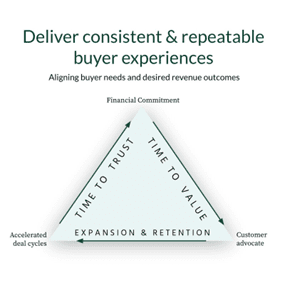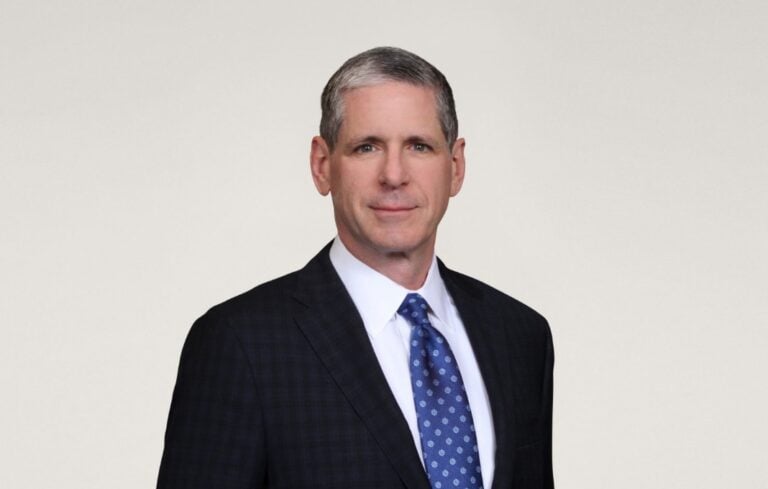


In times of market volatility—think 1991, 2001, 2008—the companies that come out the other side stronger are the ones that act with ruthless prioritization and unwavering commitment. I would posit that these organizations focus on two key things, specifically within their revenue operations, to drive efficiency and scalability in a down market: consistency and repeatability.
So how do you create consistency and repeatability? A level of standardization within the revenue workflow is paramount. Revenue leaders must ensure that, as my grandmother used to say, everyone is singing from the same song book. To scale, you need to invest in building a framework that allows for time-tested and proven actions to be codified and served up to customer-facing employees at the opportune time—driving results with predictability and cycle-time efficiency.
Today, this can be achieved through a proactive engagement model of capturing buyer signals and translating them into seller actions. This engagement model resides on top of a proven set of workflows, driving the right behaviors to yield consistent results.
To some extent, it’s inevitable that companies lose repeatability as they scale. If you have 10 employees interacting with customers, your revenue leader can walk around the office each day, inspect what the team is doing and coach them in the same direction without technology to assist them. But in revenue organizations with hundreds or thousands of employees, this level of visibility becomes a challenge that can threaten to derail growth in a sink-or-swim economic environment.
Without visibility across the entire sales organization, revenue leaders don’t know how to synthesize feedback they are getting from the market nor distinguish seller perceptions from factual deal dynamics. They don’t know why Justine closed a deal and Robert didn’t. Is it because Justine had a more compelling value proposition, or because she had a better relationship with the customer? Leaders know they want more deals like Justine’s, but they don’t know how to replicate it at scale.
Every business has a small percentage of sellers like Justine who drive the most significant performance, and revenue leaders need to be able to pinpoint what those sellers are doing right, codify it and have a system of execution where that behavior is standardized in the workflow of their tier 2 and tier 3 players.
That’s not to say there’s no room for employees to flex their own strengths. Diversity is an asset to the business. But what’s important is ensuring your sellers are armed with the right resources to execute with consistency and repeatability—and that your revenue leaders can inspect, measure and iterate to drive new behaviors and optimize processes across the broader customer organization.
Workflow standardization can empower your revenue team to work with more confidence, motivation and connection to customer and business outcomes. The uptick in performance can also positively impact employee morale and retention, which is critical to controlling costs in a challenging economic environment.
Standardizing workflows within sales organizations starts with the right technology. When CRM first hit the market, it transformed sales by empowering businesses with a better way to capture and manage customer data.
Fast forward to today, and we have these enormous systems of record that tell us everything we need to know about everything that has ever happened with every customer and prospect. While this is extremely valuable, the one thing CRMs don’t do with this data is inform the revenue team of what to do with it and how to use it—and that’s key to driving consistency and repeatability.
Enter: artificial intelligence. AI is transforming nearly every industry and function right now, and sales is no exception. While tools like generative AI can help employees draft pitches and write reports and meeting follow-ups with unprecedented efficiency, the real power of AI lies in its ability to help humans identify, within the construct of their workflows, the next best action to take across dozens of accounts.
Until recently, there has been a constant disconnect in pinpointing which specific seller actions are the ones driving successful growth outcomes for businesses. With new AI capabilities, top-performing organizations will leverage technology that can now guide customer-facing employees to a prioritized set of actions that are proven to drive not only improved revenue outcomes, but more importantly, consistent customer outcomes and satisfaction. This level of sophistication will drive greater revenue predictability and consistency in a way that’s never been seen before, and it will prove to be a major driver for increased revenue growth and capital efficiency in 2024 and beyond.
If CRM is the scouting report, then AI-backed revenue workflow is the playbook. And in a down market, harnessing the power of AI to drive smarter decision-making will separate the winners from the losers. It won’t matter as much if the competitor has better players on its team if those players are performing sporadically and without direction. But if your revenue team has the power of the revenue workflow playbook, you’ll beat out that competitor every time—consistently and repeatedly.
A referenceable customer army is also a crucial element to scaling in any economy, but especially a down one. Throughout my career, I’ve learned there are three things that matter most when architecting a revenue process to help build that army:

The key to turning this triangle into a flywheel is to optimize “time to trust” and “time to value.”
If buyers trust you, your product and your processes, their risk mitigation mindset will be minimized, and they’ll be the ones who put their foot on the accelerator and force you to run faster.
By establishing trust early and following up by providing sustainable value, you can more efficiently turn that customer into a referenceable one. That customer army then helps you get that next prospect with more confidence and conviction, which in turn helps you improve cycle time, financial commitment and time to value. The flywheel accelerates.
How you establish trust and how you establish value is a very similar motion. It all starts with better revenue workflows. Codifying workflows makes them consistent and repeatable, positioning you for scalable growth.
Historically, the return companies experience with their go-to-market spend has been both opaque and inefficient as quota attainment is often realized by a smaller-than-desirable percentage of the quota-carrying employee base.
With the power of enterprise sales engagement technology, we will see a new era of market leaders emerge among businesses that adopt a first-mover mindset and implement workflow solutions at scale. This is a repeat of a similar dynamic that we witnessed in the early 2000s with SaaS platforms like Salesforce. Companies that stayed tethered to antiquated technologies simply could not keep up with first movers and ultimately struggled to attract and retain top talent, which gravitated to the first-mover mindset and the results that come with it. Similar to how the best-performing sellers mandated that their companies use SaaS CRM in the mid-2000s, we will see the same dynamic with sales engagement platforms in 2024 and beyond.



Chief Executive Group exists to improve the performance of U.S. CEOs, senior executives and public-company directors, helping you grow your companies, build your communities and strengthen society. Learn more at chiefexecutivegroup.com.
0

1:00 - 5:00 pm
Over 70% of Executives Surveyed Agree: Many Strategic Planning Efforts Lack Systematic Approach Tips for Enhancing Your Strategic Planning Process
Executives expressed frustration with their current strategic planning process. Issues include:
Steve Rutan and Denise Harrison have put together an afternoon workshop that will provide the tools you need to address these concerns. They have worked with hundreds of executives to develop a systematic approach that will enable your team to make better decisions during strategic planning. Steve and Denise will walk you through exercises for prioritizing your lists and steps that will reset and reinvigorate your process. This will be a hands-on workshop that will enable you to think about your business as you use the tools that are being presented. If you are ready for a Strategic Planning tune-up, select this workshop in your registration form. The additional fee of $695 will be added to your total.

2:00 - 5:00 pm
Female leaders face the same issues all leaders do, but they often face additional challenges too. In this peer session, we will facilitate a discussion of best practices and how to overcome common barriers to help women leaders be more effective within and outside their organizations.
Limited space available.

10:30 - 5:00 pm
General’s Retreat at Hermitage Golf Course
Sponsored by UBS
General’s Retreat, built in 1986 with architect Gary Roger Baird, has been voted the “Best Golf Course in Nashville” and is a “must play” when visiting the Nashville, Tennessee area. With the beautiful setting along the Cumberland River, golfers of all capabilities will thoroughly enjoy the golf, scenery and hospitality.
The golf outing fee includes transportation to and from the hotel, greens/cart fees, use of practice facilities, and boxed lunch. The bus will leave the hotel at 10:30 am for a noon shotgun start and return to the hotel after the cocktail reception following the completion of the round.